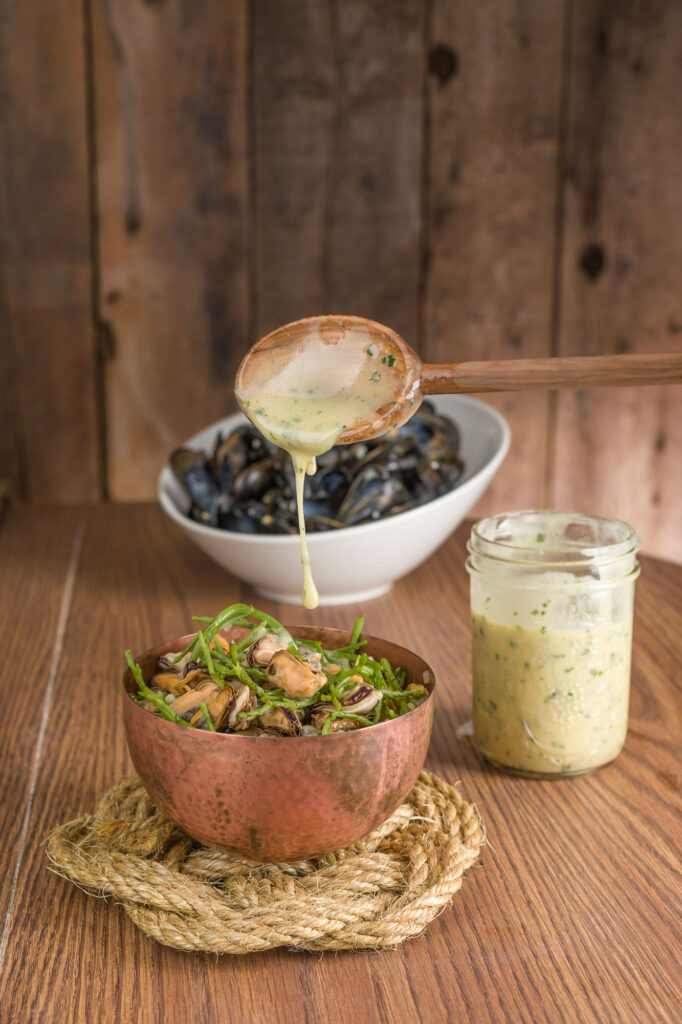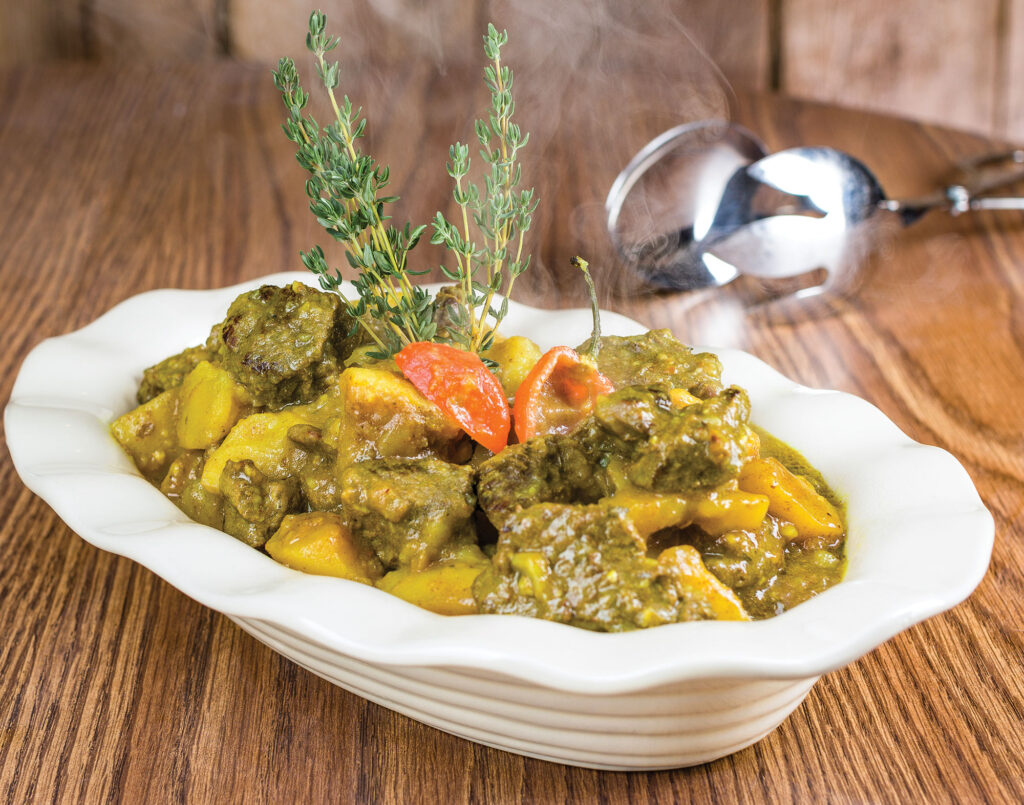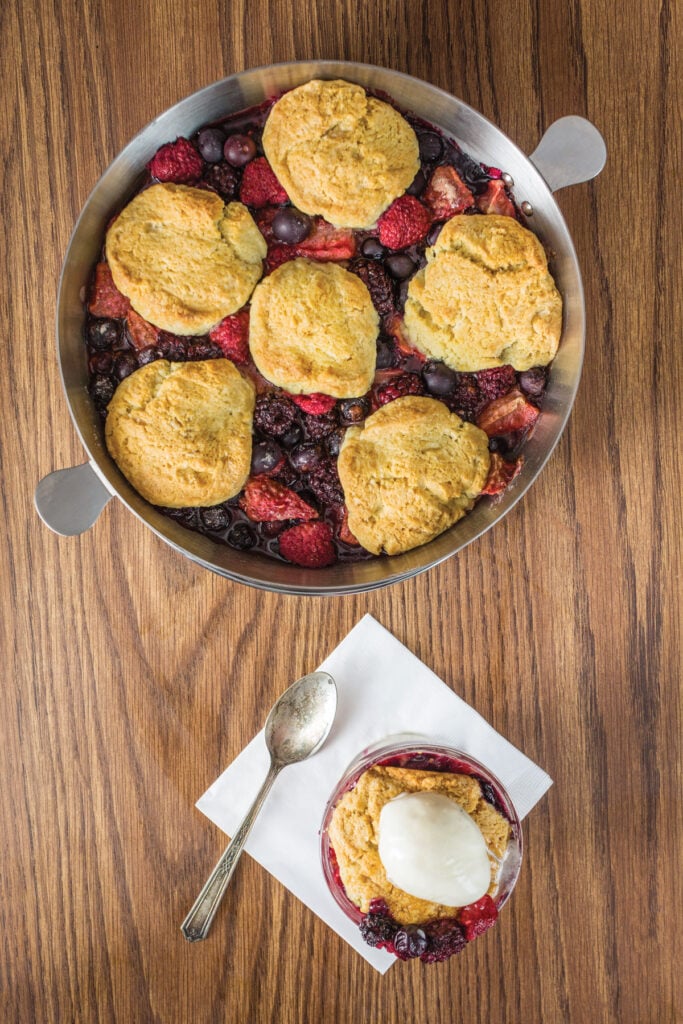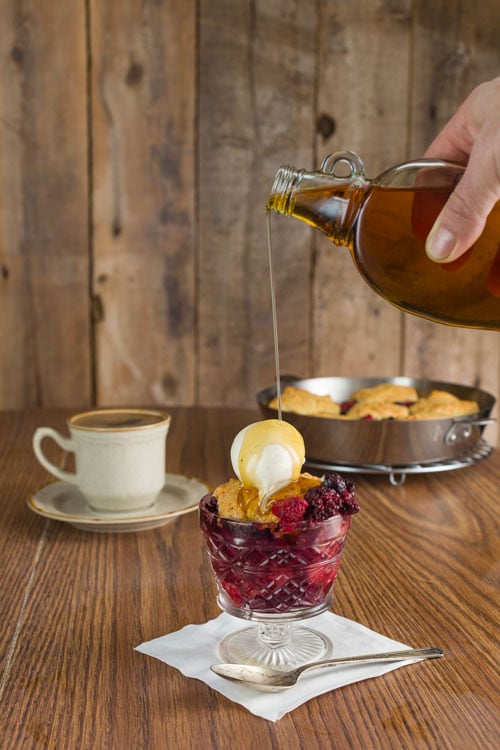Recipe styled and photographed by Derek Bissonette
From our April 2019 issue
Ragged Island, once home to farmers, rumrunners, and the poet Edna St. Vincent Millay, lies 3 miles off the coast of Bailey Island, in Harpswell, in Casco Bay. My grandparents bought the land from Millay’s estate in the 1950s, and when the house there burned down years later, my parents spent a few summers building a new one, sleeping in a tent in a field as they worked. I was in that tent too, as a baby. My brothers followed me into the house, then our wives, and now our children, a fourth generation spending summer weeks off the grid, with no electricity or running water, with kerosene lamps and piles of books, with wood and water to fetch, berries to harvest, and dinners to cook.

What follows is a taste of one of those meals, recipes for a dinner to evoke islands far from Maine, using ingredients found in Maine. It calls for foraging, yes, but also depends on the canned goods and condiments that are staples of living far from the store. And naturally, at least to me, it all tastes best if cooked on a woodstove in the evening sun as a wet dog sleeps in the most inconvenient place on the floor, as children finish a puzzle at the kitchen table. One rises to prepare the cobbler. Another slides down next to the dog to read. My wife is on the porch, drawing the landscape she draws every year. Eventually, we’ll eat and toast the food and our great good luck to have it. — Sam Sifton


Mussel Salad with Sea Beans
This is pretty continental fare, but the main flavors come from the seashore not far away: mussels from the ledges that reveal themselves like alligators at low tide; sea beans (sometimes called samphire or glasswort) from the marshy rim of the harbor. You could make the dressing with a little less mustard and a little mayonnaise, if you want, and you could omit the tarragon and replace it with curry powder if you’d like to nod at the main course.
WHAT YOU’LL NEED
1 cup white wine
1 cup water
2 garlic cloves, peeled and smashed
2 shallots, peeled and minced
1 celery rib, diced
1 bay leaf
6 black peppercorns, if you have them
2 pounds mussels, cleaned and debearded
¼ cup olive oil
2 tablespoons white wine vinegar
1 tablespoon Dijon mustard
2 teaspoons tarragon leaves, minced
kosher salt and freshly ground black pepper
½ pound sea beans, cleaned and trimmed and soaked in cold water for 20 minutes
1. Put a large pot over medium-high heat and add to it the wine, the cup of water, and the garlic, shallots, celery, bay leaf, and peppercorns, if you have them. When the mixture comes to a boil, lower the heat, cover the pot, and simmer for a few minutes, then gently add the mussels. Raise the heat back to medium-high and cook, removing the mussels as they open, for an additional 5 to 7 minutes. Discard any mussels that don’t open. Allow the cooked mussels to cool a little, then remove them from their shells and put them in a medium-size bowl and set aside
2. Make the dressing. Whisk the oil with the vinegar and mustard until it emulsifies, then add the tarragon and mix again. Taste and add salt and pepper as needed.
3. Add the sea beans to the mussels and dress with a few tablespoons of the dressing, then mix the salad around and taste it. You may wish to add more dressing. Serve plain or with crackers.

Curried Goat

Goat meat is a comer along the Maine coast, as farmers bring goats in for dairy, meat, and wool. My brother, who lives in Brunswick, almost never fails to bring me some when he visits the island — stew meat and ground meat alike — and I almost never fail to make it into this curried goat entrée, a taste of my Brooklyn childhood brought to an island in Maine.
WHAT YOU’LL NEED:
1½ to 2 pounds ground goat or 3 pounds goat meat, generally leg or shoulder, cut into 2-inch cubes
¼ cup to ½ cup neutral oil, like canola
1 large yellow onion, peeled and chopped
6 garlic cloves, peeled and minced
1 Scotch bonnet chile, sliced in half, seeds removed, or 2 jalapeño peppers, cut in half and seeds removed
3 fresh thyme sprigs
2 teaspoons kosher salt or to taste
¼ teaspoon ground black pepper or to taste
4 tablespoons Jamaican curry powder or what curry powder you have
3 medium yellow potatoes, peeled and chopped into 1-inch pieces
2 cups water
2 tablespoons mango chutney or more to taste.
1. If you’re using ground goat, proceed directly to step 2. If you’re using whole pieces of goat meat, put them in a large bowl and add to them the oil, onion, garlic, chile, thyme sprigs, salt, pepper, and curry powder. Mix with a big spoon, cover, and marinate for as long as you can manage, up to a day, although I’ve cooked it right away plenty of times.
2. Heat a large, heavy-bottomed pot or Dutch oven over medium-high heat. Swirl a heavy splash of neutral oil into it and allow it to come to a simmer. Add either the marinated pieces of goat or the ground goat followed by the onion, garlic, chile, thyme sprigs, salt, pepper, and curry powder, then cook, stirring often, until the meat begins to crisp and the onions have softened. Add the potatoes and 2 cups water. Continue cooking over medium-high heat until the mixture comes to a boil.
3. Reduce heat to low, cover the pot, and simmer, stirring occasionally, until the potatoes begin to fall apart, the sauce has thickened into stew, and the meat is tender and cooked through, 1½ to 2 hours. Add the mango chutney to taste, stir, and cook through. Serve with rice and peas.


Cornbread
This cornbread is a little sweeter and more cakelike than anything you’d find in the South. But it’s powerfully good. You could cut some diced jalapeño into the batter if you’d like, or cook a slice of bacon in the pan while it’s heating in the oven before you bake the bread. Don’t have corn? Omit! It’ll still be very nice.
WHAT YOU’LL NEED:
1½ cups all-purpose flour
1½ cups yellow cornmeal
½ cup white sugar
½ teaspoon salt
1 tablespoon baking powder
2 large eggs
1½ cups whole milk
1½ tablespoons vegetable oil
¼ cup melted butter
2 cups fresh or frozen corn kernels
1. Heat oven to 350. Lightly oil a 9-inch cast-iron skillet and put it in the oven. In a large bowl, sift together the flour, cornmeal, sugar, salt, and baking powder. In another bowl, whisk together the eggs, milk, and oil. Pour the wet ingredients over the dry ingredients, add the melted butter and the corn, and stir together until just mixed.
2. Remove the hot cast-iron pan from the oven and pour the batter into it, then give the pan a smack on a cutting board to even it out. Return pan to oven and bake, approximately 1 hour, until the cornbread is browned on top and a toothpick or a thin knife inserted into the top comes out clean.

Rice and Peas
You can serve curried goat with plain rice if you like, but the fiery sweetness of coconut rice and pigeon peas is an even more worthy match. It takes advantage of island-life pantry staples as well, with the canned milk and peas. If you don’t have pigeon peas, red kidney beans will do in a pinch.
WHAT YOU’LL NEED:
4 tablespoons (½ stick) unsalted butter
2 small yellow onions, peeled and cut into small dice
4 garlic cloves, peeled and minced
2 cups long-grain white rice
2 tablespoons fresh thyme leaves
two 13-ounce cans coconut milk
2 cups water
1 whole Scotch bonnet chile (optional)
two 15½-ounce cans pigeon peas
¼ cup chopped scallions, green part only kosher salt and freshly ground black pepper
1. Melt the butter in a medium saucepan set over low heat. When the butter begins to foam, add the onions and garlic, stir, and allow to soften for 3 to 5 minutes.
2. Add the rice and thyme to the onion mixture and stir to combine. Add the coconut milk and 5 cups water and turn the heat to high. Bring the liquid to a simmer, then lower the heat. If using the Scotch bonnet, place it in the center of the pot. Cover and cook 25 to 30 minutes, until the liquid is absorbed and the rice is soft.
3. Remove the pan from the heat and fluff the rice with a fork. If you’ve used the Scotch bonnet, remove it. Add the pigeon peas and scallions, then stir to combine. Season to taste with salt and black pepper, then cover the pot again, heat through, and keep warm until you’re ready to serve.


Every Berry Cobbler
Sometimes you luck into a quart of blackberries or maybe a combination of black ones and red ones. Some years are great for blueberries. Other times, you need to mix the few you’ve got with apples. Scant strawberries? There is always rhubarb to fill out the pan. (I like that one with a drizzle of maple syrup.) Think of this cobbler as an any-berry dessert — or in a pinch, an any-fruit dessert.
FOR THE TOPPING, YOU’LL NEED:
1¾ cups all-purpose flour, plus more for dusting
¼ cup granulated sugar
1 tablespoon baking powder
½ teaspoon baking soda
⅛ teaspoon kosher salt
5 tablespoons unsalted
butter, cold, cubed
1 cup heavy cream
FOR THE FILLING, YOU’LL NEED:
8 cups berries — raspberries, strawberries, blueberries, blackberries, or really any fruit you have, alone or in combination
½ to 1 cup granulated sugar or packed dark-brown sugar (taste as you go)
1 tablespoon fresh lemon juice
2 tablespoons cornstarch (optional)
1 to 2 teaspoons ground cinnamon
1 tablespoon unsalted butter
1. Make the topping. Using a fork, mix together the flour, granulated sugar, baking powder, baking soda, and salt. Add the cubed butter in batches and keep working the dough with the fork until the mixture looks like a bunch of floury beans. Drizzle in the cream and mix again, just to combine.

2. Transfer the dough to a lightly floured surface and pat it all together into a mound. Using a spoon or ice cream scoop, take off tablespoon-size pieces of dough and roll them into balls — you’ll probably end up with somewhere between 8 and a dozen. Put the balls on a sheet pan and press them down into biscuits that are about ¾-inch thick, then cover the pan with plastic wrap and put in the refrigerator for anywhere from 30 minutes to the better part of a day.
3. When you’re ready to bake, heat the oven to 350. Then, make the filling. In a large bowl, toss together the fruit, sugar to taste, a little lemon juice for acidity, the cornstarch (if you’d like the filling to have some body to it), and the cinnamon.
4. Use the butter to grease a 13-by-9–inch baking pan or a similar-size gratin dish, then add the fruit to it, so that it comes somewhere between halfway and three-quarters of the way up the sides of the pan. Top with the biscuits, place the pan on a sheet pan, and bake until the tops are golden and the fruit is bubbling beneath them, about 1 hour. Serve plain or, if you like, drizzled with more cream or with ice cream alongside.




